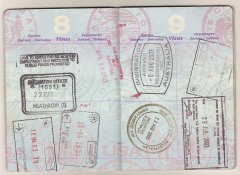By Mike Stephens
In a civil case, Zhikeng Tang v. Loretta E. Lynch, decided today, October 28, 2016, the Fourth Circuit denied petition for review of an order from the Board of Immigration Appeals (“Board”) denying requests for asylum, withholding of removal, and protection under the United Nations Convention Against Torture and Other Cruel, Inhuman or Degrading Treatment or Punishment (“CAT”). The Court ultimately denied the Petitioner’s petition for review because substantial evidence supported the Board’s decision.
Facts and Procedural History
The Petitioner, Zhikeng Tang (“Tang”), is a native and citizen of China. In July 2009, Tang entered the United States illegally. Tang was introduced to Catholicism in 2011 and began attending a church. In 2011, Tang filed for asylum and the United States government began removal proceedings.
At a hearing before an immigration judge (“IJ”), Tang requested asylum, withholding of removal, and CAT protection based on his religious practice. Tang produced evidence of his membership in the Catholic Church and testified that his faith was genuine. Tang argued that his practice of the Catholic faith required attendance in an underground church in China and not a church sanctioned by the Chinese government. Tang claimed that removal to China would result in persecution from the Chinese government due to his participation in an underground church. In support of this argument, Tang provided the IJ with letters from his family that showed underground churches in China were persecuted. In addition, Tang also produced two State Department reports that criticized the Chinese government’s treatment of religious groups in China.
While the IJ found Tang’s testimony to be credible, the IJ rejected Tang’s asylum request. The IJ found that Tang did not provide sufficient evidence to show that Tang “faces an objectively reasonable risk of persecution on account of his Roman Catholicism.’ Additionally, because Tang’s claim for asylum failed, the IJ determined Tang had failed to meet the higher standard required for withholding of removal. Lastly, the IJ also concluded that Tang did not show sufficient evidence that his chances of torture were “more likely than not” upon removal to China.
The Board, on administrative appeal, upheld the IJ’s conclusion that Tang had failed to meet his burden for asylum or withholding of removal. The Board noted that Tang had not shown that the Chinese government knew or would gain knowledge of Tang’s faith and that Tang had not “established that there is a pattern or practice of persecution in China of persons similarly situated to him.” In addition, the Board concluded that Tang had waived his CAT claim because he did not challenge the IJ’s ruling on this claim. Tang appealed, challenging the Board’s denial of asylum, withholding of removal, and CAT protection.
Asylum
Tang argued the Board erred in denying his request for asylum, claiming that he met his burden of proof required for showing a fear of persecution in China. Tang claims that the instances of persecution evidenced in the letters from China and the State Department reports show a “pattern or practice of persecution in China.”
The Fourth Circuit rejected Tang’s argument and upheld the Board’s denial of asylum. The Court held that Tang’s evidence was not sufficient to allow a reasonable fact-finder “to conclude that the requisite fear of persecution existed.” While the Fourth Circuit found that Tang satisfied the subjective component required for asylum, the Court determined that Tang had failed to demonstrate an objective fear of persecution.
The Court found that Tang did not meet either of the requirements to satisfy the objective component provided for within 8 C.F.R. § 1208.13(b)(2). First, the Court concluded that Tang had waived a challenge to the Board’s conclusion that he would face individual persecution from the Chinese government because he failed to raise this argument. Second, the Fourth Circuit determined that Tang did not satisfy his burden of proving “an objectively reasonable chance” of facing a pattern or practice of persecution in China. The Court noted that the two State Department reports that Tang provided showed that the Chinese government recognized the Catholic faith and also permitted practice of the faith in churches and at home. Additionally, the reports and the letters from Tang’s family only showed “random” or “isolated and sporadic” instances of harassment. Thus, because the persecution was not “thorough or systematic,” the Fourth Circuit declined to “disturb the Board’s conclusion that Tang failed to establish a well-founded fear of persecution.”
Withholding of Removal
Tang also claimed the Board’s refusal to grant his application for withholding of removal was erroneous. Tang argued that the evidence he provided in support of his claim for asylum was sufficient to grant his withholding of removal.
The Fourth Circuit held that Tang did not meet the necessary burden to entitle him to a withholding of removal. The requisite burden of proof in a withholding of removal claim is that of a “clear probability,” which means “it is more likely than not that [Tang’s] life or freedom would be threatened in the country of removal.” The Fourth Circuit noted that this burden of proof “is more demanding than that of asylum” and that an applicant’s claim for withholding of removal would fail when their claim for asylum failed. Therefore, the Fourth Circuit held that Tang had failed to satisfy his burden or proof and was not entitled to a withholding of removal.
Protection Under CAT
Lastly, Tang appealed the Board’s denial of protection under CAT. Tang asserted that his evidence showed that the Chinese government’s torture of unregistered church members was “prolific in China.”
The Fourth Circuit refused to review this claim due to lack of jurisdiction. Under 8 U.S.C. § 1252(d)(1), courts can only review an order of removal once the “alien has exhausted all administrative remedies available to the alien as of right.” The Court held that Tang did not exhaust his administrative remedies because he failed to bring this issue on appeal before the Board.
Disposition
The Fourth Circuit ultimately denied Tang’s petition for review of the Board’s decision.












